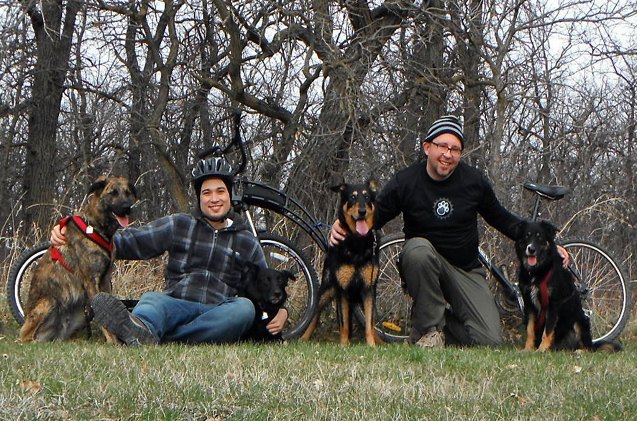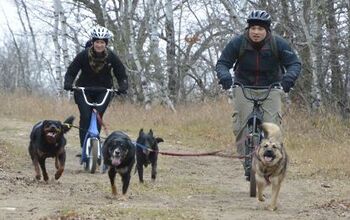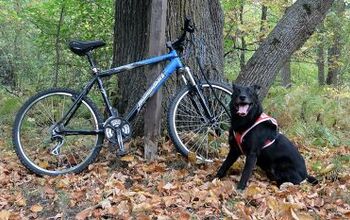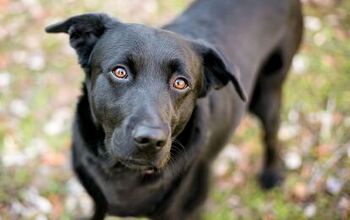Wheely Good Time: Bikejoring and Scootering Part 2

In my last article, we talked about the basics of Bikejoring and Scootering – the importance of the right gear, safety, location and training. Now, let’s get into the nitty gritty of these pulling sports.
Bikejoring
This is how I started out with running dogs. I had a dog who wanted to pull and this sport was a natural fit. In bikejoring, the dog wears a properly fitted harness, and is attached to the bike or to the rider, with a gangline. The dog pulls, the rider pedals, and fun is had all around!
Bikejoring is a great option for people with one dog, or who may not have the fitness level (or the knees) to scooter with their dogs. The mechanical advantage of the bike means you can go faster and farther, with your dog doing less work. But there’s a flip side to this as well: you have to be careful that your dog isn’t getting over tired while you breeze along in a low gear.
Bikejoring is awesome for smaller dogs to get involved in pulling sports. Lots of Jack Russells enjoy the challenge of mushing, but are too small to pull a sled. When hooked properly to a bike, they can pull safely. As well, if there’s a large weight difference between you and your dog, bikejoring is the way to go.
If you have more than one dog you plan on running, invest in a scooter. With two dogs pulling, it negates the mechanical advantage of the bike, and all you’ll be doing is sitting there. That isn’t any fun for anyone. Remember, it’s not your dog’s job to pull you around – bikejoring is a team sport.
Scootering
Scootering is another amazing way to exercise your dogs, all while getting strange looks from other trail users! If you’re running more than one dog, a scooter is the safer option.
Related: How To Cycle Sanely And Safely With Your Dog
There are a few scooters on the market that are appropriate or built for the purpose of running dogs. When you look for a scooter, you need to find one that fits your body and your style of riding. I once had a scooter with such a small foot plate that I could only stand one leg at a time. On top of that, the handle bars were set so low that it hurt my back. That scooter found a new home with someone equipped with a shorter, smaller-footed enthusiast.
Your scooter should have a brake mechanism that can easily control the front and back brakes easily. Another common factor often overlooked is that the scooter should have enough clearance to manage the kinds of trails you plan on riding. There is nothing worse than coming to a sudden stop because your scooter bottomed out on the trail!
Getting Caught Up With Antennas
For both scootering and bikejoring with your dog, you’re going to attach the gangline to the stem, which is located under the handlebars. If your dog suddenly veers to one side in pursuit of a squirrel, you’ll still be able to maintain control and can steer yourself and your dog away from danger. The only problem I’ve found when attaching to the stem is that the gangline sits a few inches lower than I like… that means the gangline is closer to your front wheel.
I recommend equipment that will keep the gangline out of your wheel. Even if the line touches the wheel for a second, it will wrap around your tire, bringing your dog into dangerous proximity of the wheel and also stopping the whole rig quickly. There are scooters on the market with a “brush bow” already attached. This handy device comes out over the wheel and keeps the line from getting caught. These are the types of scooters I recommend to my students who are just starting out in the sport.
An experienced team of well-trained dogs will keep the line tight no matter what, but if you are just starting out in this sport, consider adding a pool noodle or length of PVS pipe to protect your gangline from hitting the wheel. If the line goes slack and sags to the wheel, the pool noodle or PVC pipe won’t allow it to get caught and tangled.
People sometime purchase an attachment that’s meant to position the dogs to run beside their bike, but mount it to the front of the bike instead. I advise against this dangerous practice, as none of the side mount attachments are meant for the strain of a dog pulling on them. I have yet to come across a stationary front bike attachment that’s sound enough to hold up in an accident. If you lose control of your scooter or bike and you’ve attached a pole to the front, there is a real danger that you, your dog, or another trail user will be injured.
Overheating
Since scootering and bikejoring are usually done in warmer weather, would-be urban mushers need to address the heat. Heat stroke has a quick onset and can be fatal to a dog. Your dog is working hard and may be so willing to please that he’ll run himself past his limit. Know the signs of heat stress in your dog. I run dogs in the early morning, before the ground heats up. But there are months that we simply skipping pulling exercises because it’s too hot to safely run them.
Should I Go With a Scooter or a Bike?
For me, it comes down to numbers. For someone running one dog, a bike is the way to go. If you’ve got yourself a pack, going with a quality off-road scooter is your safest bet. I ride both, and for me, it depends on my mood and how many dogs I want to take. If I come across a hill on my bike, I just stand up and pedal harder to help the dog. If I run the same hill on my scooter, I hop off, and run along to help out the team.
Either way, the investment and enjoyment you will get out of this sport is worth it. Whether you choose a scooter or bike, it doesn’t matter – both will provide years of enjoyment and health benefits for years to come!

Kevin Roberts lives for adventure. Together with his pack of rescue dogs and his husband, he spends as much time outdoors as possible. Kevin lives by the motto: "Get outside and play with your dogs!
More by Kevin Roberts



























